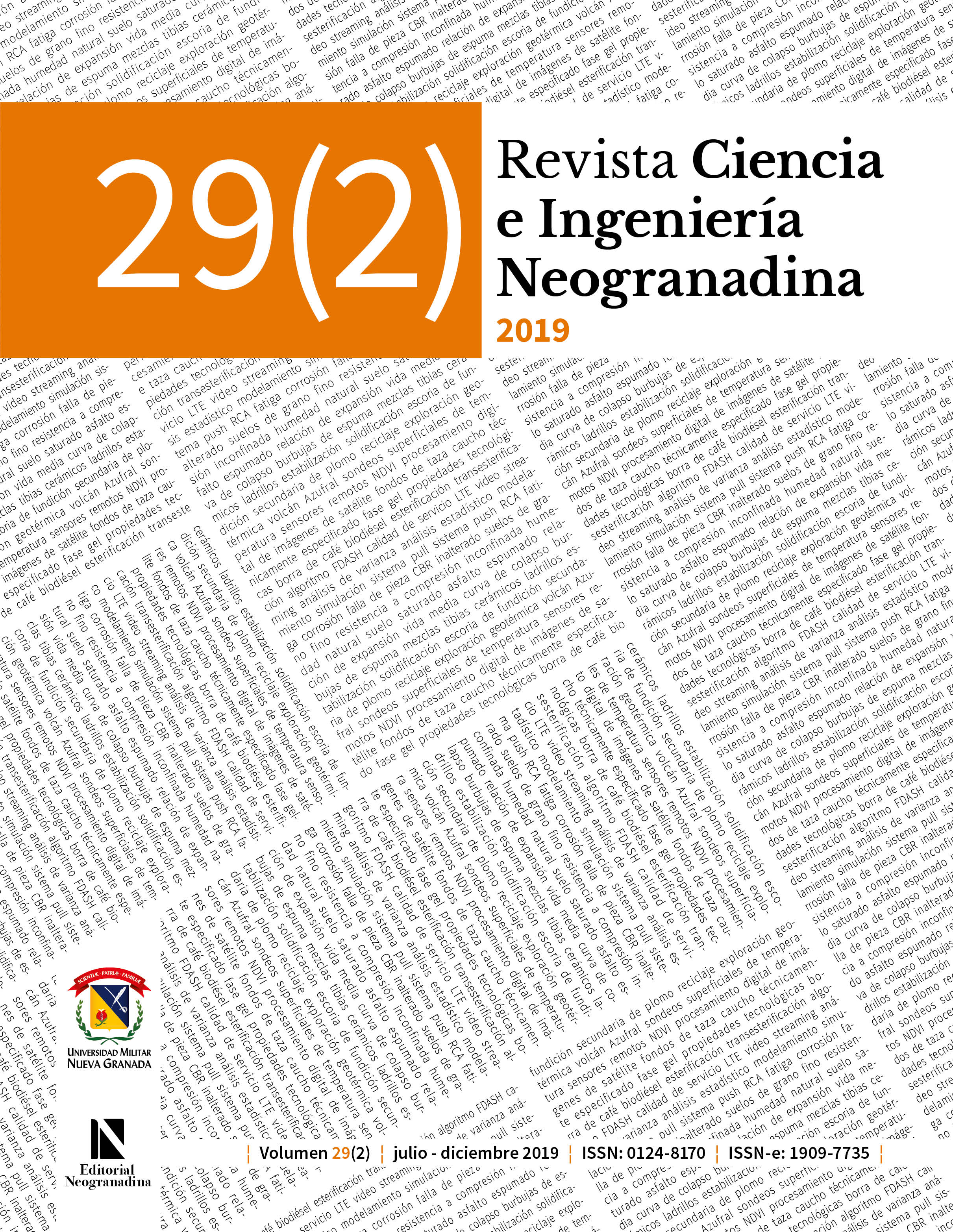Artificial Neural Model based on radial basis function networks used for prediction of compressive strength of fiber-reinforced concrete mixes
Abstract
A complex nonlinear relationship exists between the factors influence the compressive design strength of steel fiber reinforced concrete. This relation between input variables, the factors, and the output variable as it is the compressive design strength can be obtained by using an artificial neural model, which has characteristics of self-adapting, self-study and nonlinear mapping. An application of a radial basis function artificial neural model is presented in this paper. Compressive design strengths of steel fiber reinforced concrete endured mixes with diverse proportioning was predicted and compared with the experimental measured results. The predicted values were analyzed by R lineal correlation factor. The results showed that the predicted values based on radial basis function networks presented coincidence with the experimental values, and the predictability of the mechanical property of the neural model is better than that of the multi-layer neural models developed previously by the authors. The training of the neural models allowed us to conclude that the use of materials relationships is a better indicator for the comparison between different dosages of concrete mixtures that lead to similar compression strengths. A future agenda is opened in the generation of new methods of studying in metal fiber reinforced concretes compression design strength reinforced in the field of engineering.
Downloads
References
Niño H., J.R.; (2010). Tecnología del Concreto. Tomo I: Materiales, propiedades y diseño de mezcla. Asociación Colombiana de Productores de Concreto, ASOCRETO, Bogotá, Colombia. ISBN: 978-9588564036.
Metha, P.K.; Monteiro, P.J.M.; (2006). Concrete, Microstructure, Properties and Materials. 3rd edition. McGraw-Hill, USA. ISBN: 978-0071797870.
González S., L.O.; Guerrero Z., A.P.; Delvasto A., S.; Will, A.L.E.; (2014). Estimación del índice de tenacidad flexural I5 en concretos fibro-reforzados, usando redes neuronales artificiales. Revista Colombiana de Materiales, 5: 24-29. ISSN: 2256-1013.
Tsivilis, S.; Parissakis, G.; (1995). A mathematical-model for the prediction of cement strength. Cement Concrete Research, 25 (1): 9-14. ISSN: 0008-8846.
Kheder, G.F.; Al-Gabban, A.M.; Abid, S.M.; (2003). Mathematical model for the prediction of cement compressive strength at the ages of 7 and 28 days within 24 hours. Materials and Structure, 36 (10): 693-701. ISSN: 1359-6873.
Zain, M.F.M.; Abd, S.M.; (2009). Multiple regressions model for compressive strength prediction of high performance concrete. Journal of Applied Sciences, 9 (1): 155-160. ISSN: 1812-5654.
Chopra, P.; Kumar S., R.; Kumar, M.; (2015). Artificial Neural Networks for the Prediction of Compressive Strength of Concrete. International Journal of Applied Science and Engineering, 13 (3): 187-204. ISSN: 2308-5088.
González-Salcedo, L.O.; Guerrero-Zúñiga, A.P.; Delvasto-Arjona, S.; Will, A.L.E.; (2012). Aplicación de la Inteligencia Artificial en el diseño de mezclas de concreto. Estado del Arte. Cuaderno Activa, 4: 55-56. ISSN: 2027-8101.
González S., L.O.; Guerrero Z., L.O.; Delvasto A., S.; Will, A.L.E.; (2012a). Red Neuronal Artificial para estimar la resistencia a la compresión, en concretos fibro-reforzados con polipropileno. Ventana Informática, 26: 11-28. ISSN: 0123-9678.
González S.; L.O.; Guerrero Z., A.P.; Delvasto A., S.; Will, A.L.E.; (2012b). Exploración con Redes Neuronales Artificiales para estimar la resistencia a la compresión, en concretos fibroreforzados con acero. Ciencia e Ingeniería Neogranadina, 22 (1): 19-41. ISSN: 0124-8170.
González-Salcedo, L.O.; Guerrero-Zúñiga, A.P.; Delvasto-Arjona, S.; Will, A.L.E.; (2016). Redes neuronales artificiales para estimar propiedades en estado fresco y endurecido, para hormigones reforzados con fibras metálicas. Cuaderno Activa, 9: 95-107. ISSN: 2027-8101.
Bhunia, G.S.; Shit, P.K.; Maiti, R.; (2016). Spatial variability of soil organic carbon under different land use using radial basis function (RBF). Modeling Earth Systems and Environment, 2:17. ISSN: 2363-6203, 2363-6211. Doi: 10.1007/s40808-015-0070-x
Heddam, S.; (2016). Simultaneous modelling and forecasting of hourly dissolved oxygen concentration (DO) using radial basis function neural network (RBFNN) base approach: a case study from the Klamat River, Oregon, USA. Model Earth Syst Environ, 2:135. ISSN: 2363-6203, 2363-6211. Doi: 10.1007/s40808-016-0197-4
Pal, S.; Manna, S.; Chattopadhyay, B.; Mukhopadhay, S.K.; (2016). Carbon sequestration and its relation with some soil properties of East Kolkata Wetland (a Ramsar Site): a spatio-temporal study using radial basis functions. Model Earth Syst Environ, 2:80. ISSN: 2363-6203, 2363-6211. Doi: doi.org/10.1007/s40808-016-0136-4
Chen, X.; Fei, J.; Yuan, X.; (2018). High-performance Concrete Strength Prediction Model Based on the Radial Basis Function Neural Network of Human Cerebral Cortex. NeuroQuantology, 16 (5): 862-869. ISSN: 1303-5150. Doi: 10.14704/nq.2018.16.5.1404
Li, N.; Zhao, J.H.; Wang, J.; Zhu, Q.; (2014). Prediction of Hybrid Fiber Reinforced Concrete Strength on Base of RBF & BP. Proceedings of 2014 International Conference on Material Science and Engineering, published in: Advanced Materials Research, 1035: 180-135. ISSN: 16628985. Doi: 10.4028/www.scientific.net/AMR.1035.180
Noguchi, T.; Maruyama, I.; Kanematsu, M.; (2003). Performance based design for concrete mixture with multi-optimizing Genetic Algorithm. In: Proceedings of the 11th International Congress on the Chemistry of Cement (ICCC): “Cement’s contribution to the development in the 21st Century (11-16/05/2003), Durban (South Africa): Cement & Concrete Institute. (Grieve, G. & Owens, G.; Editors), pp. 1921-1930. ISBN: 0-9584085-8-0. Publication by Tech Books International, ISBN: 8-1883051-0-3.
Sánchez D.G., D.; (2000). Tecnología del concreto y del mortero. Biblioteca de la Construcción Bhandar Editores, Bogotá. ISBN: 978-9589247044.
Chan Y., J.L.; Solís C., R.; Moreno, E.I.; (2003). Influencia de los agregados pétreos en las características del concreto. Ingeniería, 7 (2): 39-46. ISSN: 1665-529X.
González S., L.O.; Guerrero Z., A.P.; Delvasto A., S.; Will, A.L.E.; (2015). Elaboración de un modelo evolutivo híbrido de algoritmos genéticos y redes neuronales artificiales para dosificaciones de mezclas de concretos reforzadas con fibras metálicas. Revista de Ingeniería, (43): 46-54. ISSN: 0121-4993.
González S., L.O.; (2014). Diseño de mezclas de concreto reforzado con fibras metálicas y de polipropileno, usando Inteligencia Artificial. Tesis Doctoral (Ingeniería de Materiales), Universidad del Valle, Cali, Colombia.
Benavides C., W.; González S., L.O.; (2012). Fibras de acero para reforzamiento de matrices cementicias: Una recopilación sobre fibras comercialmente disponibles. Universidad Nacional de Colombia Sede Palmira, Palmira. Disponible en Internet: http://bdigital.unal.edu.co/7970/4/luisoctaviogonzalezsalcedo.2012_Parte1.pdf, Consulta: 20/09/2018.
Richardson, A.E.; Landless, S.; (2009). Synthetic fibers and steel fibers in concrete with regard to bond strength and toughness. Nothumbria Built Environment Research Papers, 2 (2): 128-140, ISSN: 1756-2473.
Bishop, C.M.; (2006). Pattern Recognition and Machine Learning. Springer, Singapore, 803p. ISBN: 978-038731073-2.
Rumelhart, D.; Hinton, G.; Williams, R.; (1986). Learning internal representation by error propagation. Parallel Distributed Processing: Explorations in the Microstructures of Cognition, (1): 318-362.
Hinton, G.E.; (1987). Connectionist Learning Procedures. Technical Report CMU-CS-87-115. Computer Science Department, Carnegie-Mellon University, Pittsburg, 58p.
Hinton, G.E.; (1988). Connectionist Learning Procedures. Artificial Intelligence, 40 (1-3): 185-234.
Haykin, S.; (2005). Neural Networks. A comprehensive Foundation. 2nd edition. Pearson Prentice Hall. Patparganj, Delhi, India, 823p. ISBN: 81-7808-300-0.
Powell, M.J.D.; (1985). Radial basis functions for multi-variable interpolation: A review. Proceedings of the IMA Conference on Algorithms for the Approximation of Functions and Data, Mason, J.C.; Cox, M.G.; (editors), Royal Military College of Science, Shrivenham, UK, july. ISBN: 0-198-53612-7.
Powell, M.J.D.; (1992). The theory of radial basis function approximation in 1990. In: Advances in Numerical Analysis II: Wavelets, Subdivision Algorithms and Radial Functions, Light, W.; (editor), pp. 105-210, Oxford University Press, Oxford, UK. ISBN: 978-0198534396.
Cover, T.M.; (1965). Geometrical and statistical properties of systems of linear inequalities with applications in pattern recognition. IEEE Transactions on Electronic Computers, EC-14 (3): 326-334. ISSN: 0367-7508.
Mhaskar, H.N.; (1996). Neural networks for optimal approximation of smooth and analytic functions. Neural Computation, 8 (1): 164-177. ISBN: 0899-7667.
Niyogi, P; Girosi, F.; (1996). On the relationships between generalization error, hypothesis complexity, and sample complexity for radial basis functions. Neural Computation, 8: 819-842. ISSN: 0899-7667.
Liao, Y.; Fang, S.C.; Nuttle, H.L.W.; (2003). Relaxed conditions for radial-basis function networks to be universal approximators. Neural Networks, 16: 1019-1028. ISSN: 0893-6080.
Wu, W.; Nan, D.; Long, J.L.; Ma, Y.M.; (2008). A comment on “Relaxed conditions for radial-basis function networks to be universal approximators”. Neural Networks, 21: 1464-1465. ISSN: 0893-6080.
Chen, S.; Gibson, G.J.; Cowan, C.F.N.; Grant, P.M.; (1991b). Reconstruction of binary signals using an adaptive radial-basis-function equalizer. Signal Processing, 28: 91-107. ISSN: 0165-1684.
Cuadras, C.M.; (1989). Distancias Estadísticas. Estadística Española, 30 (119): 295-378. ISSN:
Prieto G., R.E.; (2006). Técnicas estadísticas de clasificación, un ejemplo de análisis de cluster. Trabajo de Grado (Ingeniero Industrial). Universidad Autónoma del Estado de Hidalgo, Pachuca.
De Mingo L., L.F.; (2000). Nuevos métodos para el reconocimiento de patrones con redes de neuronas. Tesis Doctoral (Doctor en Informática), Universidad Politécnica de Madrid, Madrid.
García V., C.; (2017). Redes neuronales de funciones de base radial. Trabajo de Grado (Matemático), Universidad de La Laguna, La Laguna, Tenerife, España.
Kansa, E.J.; (1990). Multiquadratics – a scattered data approximation scheme with applications to computational fluid-dynamics – II. Solutions to parabolic, hyperbolic and elliptic partial differential equations. Computers & Mathematics with Applications, 19 (8/9): 147-161. ISSN: 0898-1221.
Chen, S.; Cowan, C.F.N.; Grant, P.M.; (1991a). Orthogonal least squares learning algorithm for radial basis functions networks. IEEE Transactions on Neural Networks, 2 (2): 302-309. ISSN: 1045-9227.
Buhmann, M.D.; (2003). Radial Basis Functions: Theory and Implementations. Cambridge University Press. ISBN: 0-521-63338-9.
Cardona V., Y.; Madrid de la Vega, H.; González-Casanova H., P.; (2005). De los polinomios de Lagrange a las funciones radiales. Aportaciones Matemáticas, Serie Comunicaciones, (35): 97-125. ISSN: 1870-2112.
Escobar F., W.F.; (2016). Aplicación de funciones de base radial (RBF) para la solución de ecuaciones diferenciales parciales (EDP) que aparecen en problemas de fluidos. Tesis (Magister en Ciencias Naturales y Matemáticas), Universidad Pontificia Bolivariana, Medellín.
MacQueen, J.; (1967). Some methods for classification and analysis of multivariate observations. In: Proceedings of the fifth Berkeley Symposium on Mathematics, Statistics and Probability, Vol. 1: Statistics, 281-297. Berkeley, June 21 – July 18, 1965, December 27 – January 7, 1966: University of California Press.
Kailath, T.; Sayed, A.H.; Hassibi, B.; (2000). Linear Estimation. Prentice Hall. ISBN: 0-13-397985-7.
Tusell, F.; (2011). Análisis de regresión. Introducción teórica y práctica basada en R. Universidad del País Vasco, Bilbao, 258p.
Díaz T., N.D.; (2014). La pseudoinversa en el proceso de aprendizaje del asociador lineal. Tesis (Magister en Ciencias Matemáticas), Universidad del Valle, Santiago de Cali.
NTC 673; (2010). Concretos. Ensayo de resistencia a la compresión de especímenes cilíndricos de concreto. Norma Técnica Colombiana NTC 673, Instituto Técnico Colombiano de Normas Técnicas y Certificación (ICONTEC), Bogotá, febrero 17, 7p.
THE MATHWORKS INC.; (2008). MATLAB® & SIMULINK® Release 2008a, Installation Guide for Windows. The Math Works Inc., Natick, USA, March, 105p.
Beale, M.H.; Hagan, M.T.; Demuth, H.B.; (2000). Neural Networks Toolbox: User´s Guide. Version 4.0. The Math Works Inc., Natick, USA, 404p.
Ascombe, T.W.; (1973). Graphs in Statistical Analysis. The American Statistician, (27): 17-21. ISSN:
Achen, C.H.; (1982). Interpreting and using Regression. Series/Number 07-029, Sage University Paper. Sage Publications, Newbury Park, CA, 89p. ISBN: 0-80391915-8.
Martínez R., E.; (2005). Errores frecuentes en la interpretación del coeficiente de determinación lineal. Anuario Jurídico y Económico Escurialense, (38): 315-332.
Bouami, M.F.; (2005). Desarrollo y optimización de nuevos modelos de redes neuronales basadas en funciones de base radial. Tesis Doctoral (Doctor en Informática), Universidad de Granada, Granada. ISBN: 84-338-3419-3.
Heryudono, A.; Larsson, E.; Ramage, A.; Von Sydow, L.; (2016). Preconditioning for basis radial function partition of unity methods. Journal of Scientific Computing, (67): 1089-1109. ISBN: 0885-7474.











